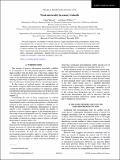Weak universality in sensory tradeoffs
Author(s)
DeDeo, Simon; Marzen, Sarah E.
DownloadPhysRevE.94.060101.pdf (401.4Kb)
PUBLISHER_POLICY
Publisher Policy
Article is made available in accordance with the publisher's policy and may be subject to US copyright law. Please refer to the publisher's site for terms of use.
Terms of use
Metadata
Show full item recordAbstract
For many organisms, the number of sensory neurons is largely determined during development, before strong environmental cues are present. This is despite the fact that environments can fluctuate drastically both from generation to generation and within an organism's lifetime. How can organisms get by by hard coding the number of sensory neurons? We approach this question using rate-distortion theory. A combination of simulation and theory suggests that when environments are large, the rate-distortion function—a proxy for material costs, timing delays, and energy requirements—depends only on coarse-grained environmental statistics that are expected to change on evolutionary, rather than ontogenetic, time scales.
Date issued
2016-12Department
Massachusetts Institute of Technology. Department of PhysicsJournal
Physical Review E
Publisher
American Physical Society
Citation
Marzen, Sarah, and Simon DeDeo. “Weak Universality in Sensory Tradeoffs.” Physical Review E 94.6 (2016): n. pag. © 2016 American Physical Society
Version: Final published version
ISSN
2470-0045
2470-0053